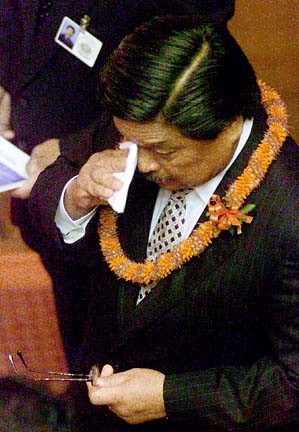

THE STATE OF THE STATE ADDRESS

|
Cayetano calls Plagued by an anemic economy at the beginning of his first term in 1995 and faced with a present-day economy that crashed like the two World Trade Center towers, Gov. Ben Cayetano sought to explain his administration today as both an economic rescue effort and a massive rebuilding.
economy strong
He says the state is not only weathering
Full text of speech
the storm but aims for a quick recoveryBy Richard Borreca
rborreca@starbulletin.comIn his final State of the State speech, Cayetano told members of the Hawaii State legislature that even after the Sept. 11 terrorist attacks, Hawaii's economy is starting to thrive.
"I am pleased to inform you that there is light at the end of the tunnel," Cayetano said.
"There are signs that our economy today is more resilient, stronger, than during the Gulf War crisis," Cayetano said.
"Not only are we weathering the storm, our chances for a quick recovery are better than we expected," Cayetano said.

|
His own state administration is partially responsible for that turnaround, Cayetano says.First, the Cayetano administration lowered taxes and put in tax incentives for technology, and new construction and renovations, Cayetano said.
The state administration also became leaner during the Cayetano years, the Governor said.
"Today state government is more efficient, it's smaller and it accounts for a smaller proportion of the economy," he said.
But, he stressed, his main concern is to balance the budget and to do that he said the state must tap the Hurricane Relief Fund and also cut the state education budget, which consumes 52 percent of the state general fund.
"If you disagree with this proposal, we are open to your suggestions," he told lawmakers.
He urged legislators to put together an economic plan that includes $900 million in state construction, saying that it would be directed at rebuilding public schools and keeping the construction industry fully employed.
In a personal aside, Cayetano noted that this speech will be his last before the Legislature as Governor.
After 28 years in public office, Cayetano said that his elections have been something out of the American Dream.
Recalling how after nearly flunking out of Farrington High School and getting into trouble with the law, he moved to California to get an education. When he came back, then-Gov. John Burns named him to an important state commission.
Cayetano asked Burns, whom he had never met, why he was named to the post, Burns replied: "Well, there are not too many young Filipinos from Kalihi who become lawyers."
"He did not have to explain, I understood what he mean and what he stood for," Cayetano said.
He said his administration has been framed by the desire to "get the job done."
In summation, Cayetano, who has been one of the state's most partisan leaders, concluded with a call for both Democrats and Republicans to work together. He singled out GOP House leader Galen Fox, Republican George W. Bush and former New York Mayor Rudy Giuliani for praise.
"So for once, put politics aside, let's discuss the issues frankly and truthfully, so the people know what's at stake.
"We owe them the truth," he said.
With his speech, Cayetano included a 36-page black and white booklet detailing the accomplishments during his two terms.
The eight years in office, Cayetano said, were marked "by the worst fiscal crisis in state history."
While the state had little extra funds, Cayetano said the state was still able to add 2,870 additional full-time positions to the Department of Education and 554 to the Health Department. Most of those additions were to comply with the federally-court-mandated Felix consent decree.
"Growth in education and special education has been nearly 19 percent, while cumulatively we have reduced personnel in all other departments by 12.1 percent," Cayetano said in the booklet.
During the Cayetano administration the state was able to lift the prison consent decree, which had in effect for 15 years because of unacceptable conditions at the state prisons.
In all Cayetano calculates that $1.3 billion in major construction projects were completed during his administration, including 13 new schools. Also completed during Cayetano's administration was the controversial H-3 interstate highway, which at $1.3 billion was the largest and most expensive public works project in Hawaii's history.
Cayetano also saw completion of the Kapolei state office building in the master-planned Kapolei second city.
Singled out for praise was Cayetano's attorney general, Earl Anzai, who the governor noted filed suit to halt the pending sale of the Honolulu Star-Bulletin.
"Earl's help saved the Star-Bulletin from being shut down and assured we would continue to have two major daily newspapers instead of just one," Cayetano said.